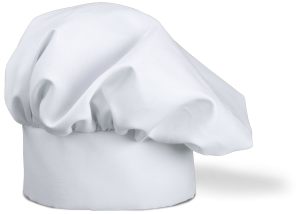Why are kitchen uniforms white?
Foot-high flames, razor sharp knives and vats of boiling liquids are just a taste of the occupational hazards found in almost any restaurant. Because of these dangers, the life of a chef is full of potential injuries and requires a very specialized uniform. Add in the need to impress and you have a recipe for an outfit that is one of the most recognizable and secretly useful in the world.
The original chef outfit
First compiled by legendary French chef Marie Antoine Carême in 1822, the chef’s uniform started its rise to worldwide recognition when Georges Auguste Escoffier brought it to the Savoy Hotel in England in 1890.
While some people may consider the original white hat, double breasted coat, apron and checkered pants as an archaic outfit with little functional value, it actually has many subtle design features which protect against the hazards of a commercial kitchen.
The chef’s hat, also known as a toque, protects hair from flames, soaks up sweat and keeps hair out of the eyes and, well, your food. Carême standardized the chef’s hat into its modern recognizable form – white to show purity and supported by a starch and a stiff backing. He got the idea for the overall bright white look from a cool display of all-white military uniforms at the 1814 Congress of Vienna.


The chef’s double-breasted coat protects from hot spills. It also enables a chef to flip which side faces out, allowing them to hide stains and greet customers with a clean look. The fabric buttons are a sensible option in a kitchen—they won’t melt or chip and get into the food like metal or plastic buttons. They are also easy to undo in an emergency.
Chef aprons originally just covered the lower body in order to project against open flame cooking, which was common in the 1800’s. Open fire cooking is rarer these days, so apron function has changed in new chef uniforms to protect against spills for the most part.
The recognizable black and white finely houndstooth patterned chef pants were adopted because they hide stains better than other non-patterned fabrics.
Chefs also carry a small towel called a torchon that’s used to protect their hands when handling hot pans. This towel is not for drying hands because a wet towel will conduct heat and thus compromise the original purpose of protecting from hot equipment.
Neckerchiefs are another traditional part of a chef’s uniform. The narrow band of cloth functions like a sweatband to keep sweat from dripping.

Finally, what chef uniform is complete without the most important tool of the trade? The knife. Carême’s original outfit included a knife and it is certainly part of a modern chef’s toolkit, but it’s probably no longer carried around like the original chefs did—in a sheath worn on their side as a sword!
It all boils down to this, Carême’s highly useful chef’s uniform set the standard for restaurant kitchen wear. A few modifications were made over 200 years, but Carême’s original vision has become one of the most iconic professional uniforms in the world. Restaurants everywhere still use the clean, pressed look for their chefs and kitchen staff, keeping the back of the house looking their best when hungry customers arrive.
Register your business for free with NPP and receive discounts on essential items you use every day, including UniFirst uniform and facility services. More than 300,000 NPP members boost their bottom line with money-saving, convenient B2B pricing. Learn more about NPP.
